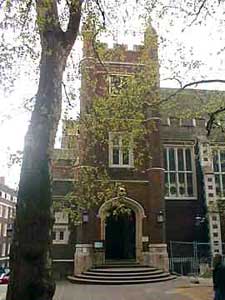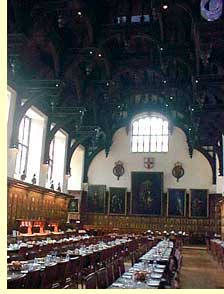|
|

Middle Temple Hall
Fountain Court, Middle Temple Lane, EC4
 There can be few places as breathtaking as Middle Temple Hall. Simply standing in a room that has remained unchanged for four hundred years is fairly awe inspiring. But to see the splendour of its double hammer beam roof and to admire the fabulous craftmanship of its wooden screen at close quarters is an experience in itself. There can be few places as breathtaking as Middle Temple Hall. Simply standing in a room that has remained unchanged for four hundred years is fairly awe inspiring. But to see the splendour of its double hammer beam roof and to admire the fabulous craftmanship of its wooden screen at close quarters is an experience in itself.
This extraordinary treasure, a genuine glimpse of Elizabethan London, is the focal point of Middle Temple, one of the oldest Inns of Court. Designed to impress, it is essentially a common room for members of the Inn who both dine and entertain here.
Middle Temple Hall stands in a courtyard at the heart of an Inn which has preserved its antique elegance and charm. This timeless quality - so well described by Charles Dickens in Barnaby Rudge - lends an atmosphere of calm that is very welcome in a busy city.
Housed inside a red brick facade faintly reminiscent of an old public school, Middle Temple Hall was constructed over a ten year period and finally completed in 1573. Although there is no record of the cost, the work must have been fabulously expensive as leading craftsmen were brought in to produce a showroom that could compete with anything in the palaces and stately homes of the day.
With rivalry running high in the legal profession, the different factions were eager to out-do each other by building bigger and more impressive buildings. Even from today's perspective Middle Temple Hall has the feel of the ultimate status symbol, so members of the Inn during Tudor times must have felt that their compulsory contributions towards it were well worth the outlay.
Then as now, social climbing was a serious sport for ambitious professionals and constructing a dining hall of this quality had at least as much to do with attracting patronage as it did with serving the needs of members. The strategy worked thanks to Edmund Plowden, the barrister who as Treasurer of Middle Temple acted both as principal and chief of works. Plowden's unflagging efforts and faultless reputation won influence at the highest levels and the Queen herself became both a benefactor and guest.
Well favoured by the sovereign, Middle Temple Hall soon developed into a kind of club house for the intellectual elite. In those days, men from outside the legal profession could join the Inn as social members and a host of famous names flocked to enjoy the debates, gaming and various revels on offer. With England's golden age of adventure then in full swing, the list of regulars included a number of seafaring heros, the most prominent of whom were Walter Raleigh, Francis Drake, Martin Frobisher and John Hawkins.
Festival times were a particular excuse for lavish entertainment and Christmas - which then extended from the feast of All Hallows on November 1st through to Candlemass on February 2nd - was given special treatment. Plays and masques were a popular part of the fun with troupes of actors being brought in for the occasion. It was during these celebrations in 1602 that London's leading band of players, the Chamberlain's Men, were invited to perform at the Middle Temple Hall. They gave the first recorded performance of Shakespeare's Twelfth Night and the playwright probably featured in the cast.
The audience seems to have enjoyed the play and one eye-witness, John Manningham, who was a member of the Temple, thought it worth recording in his diary. He wrote:
"Feb 2 at our feast (Candlemas) we had a play called Twelfth Night or What you will, much like the Comedy of Errors or Menechmi in Plautus... A good practise is it to make the steward beleeve his Lady widdowe was in Love with him by couterfayting a lettre, as from his Lady, in general termes, telling him what shee liked best in him and prescribing his gesture in smiling his apparraile etc. And then when he came to practise, making him beleeve they took him to be mad."
 This relic, like so many others that have been preserved here for generations, is one of the marvels of the Middle Temple. As if the magnificent Hall were not enough in itself, there are also the contents, any one of which would make an enviable museum piece. At the head of the Hall, for instance, is the Bench Table. A staggering twenty-nine feet long and made of continuous planks taken from a single oak, the table was put in place before the Chancellors' Window in the alcove to the left of it could be glazed. The wood for the table came from a tree felled in Windsor Great Park and it is believed to have been a gift from Queen Elizabeth I, whose portrait now graces the wall behind. This relic, like so many others that have been preserved here for generations, is one of the marvels of the Middle Temple. As if the magnificent Hall were not enough in itself, there are also the contents, any one of which would make an enviable museum piece. At the head of the Hall, for instance, is the Bench Table. A staggering twenty-nine feet long and made of continuous planks taken from a single oak, the table was put in place before the Chancellors' Window in the alcove to the left of it could be glazed. The wood for the table came from a tree felled in Windsor Great Park and it is believed to have been a gift from Queen Elizabeth I, whose portrait now graces the wall behind.
The Queen's picture, a Dutch piece painted in her lifetime, is one of a collection of six which have been assembled over the centuries. At the centre of these is a fine portrait of Charles I on horseback. From the studio of Van Dyck, a good portion of the work is apparently the master's own. On either side of this canvas hang high quality pictures of Charles II, Queen Anne, James II and William III.
To the left of this mini gallery, back in the alcove mentioned above, there are two more treasures. The first, a battered-looking rectangular table with legs that seem to have been added as an afterthought, has a very colourful history. This is the Cupboard, a table which used to be used as a lecturn in the days when a junior lawyer's training consisted mainly of listening to lectures given by senior members of the Inn. Today, the Cupboard is an important prop in a junior lawyer's graduation ceremony. When a lawyer is 'called to the Bar', that is, qualifies to practice as a Barrister, he or she steps forward to this table in order to sign the Roll. The honour is made doubly significant because the oak that forms the table top was given to the Inn by Sir Francis Drake. It is, in fact, a hatch cover which started life on a ship called The Pelican, better known by its later name, The Golden Hind.
Standing in the alcove admiring this amazing heirloom, it is impossible to miss the Chancellor's Window, which is another historic rarity. At a distance, the window looks like a rather elaborate piece of stained glass. Close up, though, the various sections of the window come into their own, for each frame contains a different coat of arms. Mostly Elizabethan, these are the arms of former lord chancellors, judges and ordinary members of Middle Temple.
A point of interest in its own right, the window has become part of a new tradition over the last hundred years. Legend has it that author Robert Louis Stevenson may have found the inspiration for one of his most famous books in the names shown on two shields here. One, bearing three deer on a burnt orange background, is the device of a certain Josephus Jekyll. Close by is the blue and yellow shield of one Roburtus Hyde. Whether the story is true or false, The Strange Case of Dr Jekyll and Mr Hyde was published in 1886.
Still central to the daily routine of Middle Temple lawyers, this remarkable hall is one of London's great survivors - the Great Fire of 1666 miraculously left it unscathed after the wind changed course and wartime bombing destroyed only a fraction of the Eastern end. Accidents of fate aside, there is no doubt that its near-perfect preservation is due to the devotion of members of the Inn. This, plus the fact that the hall remains essentially private, has assured both its future and an irreplaceable part the nation's heritage

Middle Temple Hall is not normally open to incidental visitors as it is frequently in use. Individuals may get permission to view by applying in person to the reception desk at the Treasury office but it is advisable to 'phone ahead. Guided tours can be arranged for small groups by written request.
Apply to: The Treasury Office, Middle Temple Lane, London EC4Y 9AT
Tel: 0207-427-4800.
 Blackfriars (District Line) Blackfriars (District Line)
Copyright © Jan Collie 2002
Published by permission of the author.
All rights reserved. No reproduction, copy or transmission of this publication may be made without written permission.
|
|